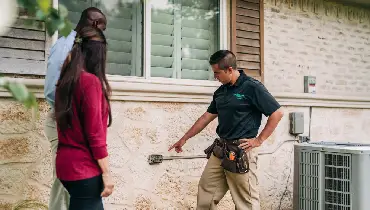
Buying a home is one of the largest investments most people will make in a lifetime. A thorough home inspection is the best protection against making an uninformed decision about this important purchase. Recognizing red flags in a home will help homebuyers identify serious concerns and limit costly repairs after purchasing a home.
Table of Contents:
- Red Flags in the Basement
- Interior Red Flags
- Water Leakage Red Flag
- Miscellaneous Red Flags Around the Home
- False Red Flags
- FAQ About Home Inspection Red Flags
Red Flags in the Basement
A thorough basement inspection can reveal critical information when it comes to the structural integrity of the property and identify if it ever sustained water damage. In fact, 98% of basements experience some sort of water damage. Knowing these warning signs before making an offer can help prevent costly repairs down the road.
Freshly Painted Walls:
While clean walls look refreshing and appealing, a recent paint job in the basement could be a sign of recent water damage, cracks, or other structural damage.
Multiple Sump Pumps:
A sump pump is used to keep water out of the basement. If a home has more than one sump pump or battery backup systems, this indicates the property frequently experiences water penetration or flooding. If this is the case, take a closer look at the walls and floor for signs of water damage.
Heavy Storage Against Walls:
Hiding wall damage behind paint isn’t the only way to conceal issues. Storing heavy furniture against walls is also a way to conceal wall damage from potential homebuyers. If possible, take a look behind furniture for signs of damage.
Added Columns:
Numerous columns in the basement could be an aesthetic addition or they could be necessary to shore up floor framing due to structural concerns or previous damage.
Interior Red Flags
Look out for these common red flags inside the home that could reveal hidden or unexposed damage and maintenance issues.
Persistent Deodorizers:
Deodorizers are pleasant and welcoming to guests, but buyer beware, they can mask odors from underlying issues. Use of deodorizers may mask pet odors that have seeped into the carpeting. They can also be used to mask damp conditions in homes that have experienced water issues.
Drapes Covering Windows:
Drapes can add character to a space. They can also hide fogging or condensation in insulated glass windows. Fogging and condensation is a sign that the window seals have failed and need to be replaced.
Furniture in Unusual Locations:
Large furniture can be used to cover stains or damage. If a piece of furniture looks out of place, this could be a sign that something is being concealed.
Water Leakage Red Flag
Water issues are among the most critical red flags due to the potential for costly repairs and potential mold growth. Be aware of freshly painted walls, ceilings, and new carpeting. These could be signs of previous water damage.
Cloth Around Plumbing Vents:
A plumbing vent, also known as a vent stack, extends from the roof of a home. These vertical pipes are vented through the roof to regulate air pressure and remove sewer gasses from the plumbing system. These vents are sealed with a rubber gasket, which will occasionally dry out and crack over time. If you see cloth tied around attic plumbing vent pipes, it could be a sign of a vent pipe or flashing leak.

Miscellaneous Red Flags Around the Home
Red flags can be found in various locations inside and outside the home. Miscellaneous red flags often relate to exterior and structural elements.
Sprinkler Stains on Exterior Walls:
Water stains on exterior walls from overspray with outdoor sprinkler systems could indicate hidden water intrusion inside the home and possible sheathing or framing damage.
Deck Carpeting:
While deckDeck carpeting is a friendly alternative to wood for young children and bare feet. Carpeting can also trap moisture, which can cause the wood under it to decay, compromising the structural integrity of the deck.
Water Treatment Systems:
Disconnected or inactive water treatment systems are not tested during a home inspection. Therefore, prospective homebuyers should have the water tested to ensure there are no water quality issues.
Multiple Electric Panels:
If a home has multiple electric panels, inquire as to why. Multiple panels may indicate the current system is outdated and unable to meet the future needs of the household when other electrical devices and appliances are added.

False Red Flags
Some things that appear to be a red flag might just be a cosmetic issue that can be easily fixed by the seller. If you see these potential issues, take a deep breath and take a deeper dive into the reasons behind them to determine if a simple fix will resolve the issue.
Roof Algae Staining:
Moderate algae staining on roof shingles may not be pretty, but algae staining does not indicate an issue with the structural integrity of the shingles or the roof.
Residual Water During Wet Conditions:
If the weather conditions are wet, you may notice some residual water on walls and floors where wet footwear was discarded or where doors and/or windows were left open. Your home inspector will make note of these conditions and use a moisture meter to check the level and to help determine the source of the moisture. Return when the weather is dry to see if these areas show any signs of consistent exposure to moisture.
Wall Joint Cracks:
While wall joint cracks could be from a structural issue, they could also result from trussing uplift, which is not a structural problem a homebuyer should be concerned with. An experienced inspector will determine if the cracks are structural in nature or cosmetic.
Cement Coating:
If you notice cement coating breaking off on the foundation, note that this is generally a cosmetic issue – not a structural concern. This can often be fixed with minimal effort and expense.
Buy Confidently When You Call In a Professional
The difference between identifying red flags that could lead to costly repairs versus false flags, is hiring a reputable and experienced home inspection professional. HouseMaster® home inspectors have the knowledge and experience to identify potential issues during a home inspection. This means you can buy with confidence knowing you are protected and secure when it’s time to make your big investment.
Book an inspection today to get a professional assessment of your potential new home.
Buying a home is exciting. Recognizing red flags can help you make a confident decision. At HouseMaster®, we explain our home inspection findings with care and transparency to help you make informed decisions. Contact us today to book a home inspection with one of our local home inspectors.
FAQ About Home Inspection Red Flags
How concerned should I be if I see red flags during a home inspection?
Red flags surrounding water damage, roof issues, HVAC issues, and/or foundation problems will need immediate attention if you are seriously considering purchasing the home. Other issues that are more cosmetic are not as concerning, since most can be remedied with less effort and expense. A professional home inspector has the proper knowledge, tools, and training to determine whether issues are cause for concern and make unbiased recommendations before you buy.
What should I do if my home inspection report has several red flags?
Homebuyers should take the time to review each issue with your home inspector to gain an understanding of the long-term implications and cost associated with each issue. For serious structural or safety concerns, your home inspector may recommend further evaluation from specialized sources such as a licensed electrician or HVAC professional.
Does a radon mitigation system mean there is a problem?
While a radon mitigation system controls radon levels within a structure to ensure the safety of occupants, it is not necessarily an indicator of a radon problem. Depending on your geographic location, many homes have radon systems installed as a precautionary measure.
